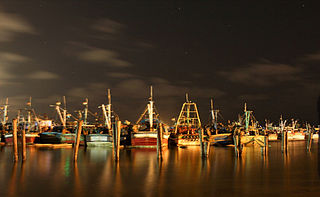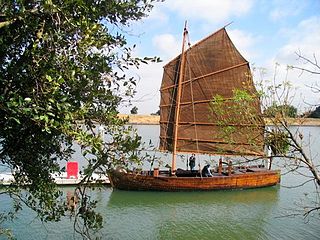
A felucca is a traditional wooden sailing boat with a single sail used in the Mediterranean—including around Malta and Tunisia. However in Egypt, Iraq and Sudan, its rig can consist of two lateen sails as well as just one.

Commercial fishing is the activity of catching fish and other seafood for commercial profit, mostly from wild fisheries. It provides a large quantity of food to many countries around the world, but those who practice it as an industry must often pursue fish far into the ocean under adverse conditions. Large-scale commercial fishing is called industrial fishing.

The Embarcadero is the eastern waterfront of Port of San Francisco and a major roadway in San Francisco, California. It was constructed on reclaimed land along a three mile long engineered seawall, from which piers extend into the bay. It derives its name from the Spanish verb embarcar, meaning "to embark"; embarcadero itself means "the place to embark." The Central Embarcadero Piers Historic District was added to the National Register of Historic Places on November 20, 2002.

Fisherman's Wharf is a neighborhood and popular tourist attraction in San Francisco, California, United States. It roughly encompasses the northern waterfront area of San Francisco from Ghirardelli Square or Van Ness Avenue east to Pier 35 or Kearny Street. The F Market streetcar runs through the area, the Powell-Hyde cable car line runs to Aquatic Park, at the edge of Fisherman's Wharf, and the Powell-Mason cable car line runs a few blocks away.

The maritime history of California can be divided into several periods: the Native American period; European exploration period from 1542 to 1769; the Spanish colonial period, 1769 to 1821; the Mexican period, 1821 to 1847; and United States statehood period, which continues to the present day. In the history of the California coast, the use of ships and the Pacific Ocean has historically included water craft, fisheries, shipbuilding, Gold Rush shipping, ports, shipwrecks, naval ships and installations, and lighthouses.

The Port of San Francisco is a semi-independent organization that oversees the port facilities at San Francisco, California, United States. It is run by a five-member commission, appointed by the Mayor and approved by the Board of Supervisors. The Port is responsible for managing the larger waterfront area that extends from the anchorage of the Golden Gate Bridge, along the Marina district, all the way around the north and east shores of the city of San Francisco including Fisherman's Wharf and the Embarcadero, and southward to the city line just beyond Candlestick Point. In 1968, the State of California, via the California State Lands Commission for the State-operated San Francisco Port Authority, transferred its responsibilities for the Harbor of San Francisco waterfront to the City and County of San Francisco / San Francisco Harbor Commission through the Burton Act AB2649. All eligible State port authority employees had the option to become employees of the City and County of San Francisco to maintain consistent operation of the Port of San Francisco.

Fisherman's Wharf is a historic wharf in Monterey, California, United States. Used as an active wholesale fish market into the 1960s, the wharf eventually became a tourist attraction as commercial fishing tapered off in the area.

Alaskan king crab fishing is carried out during the fall in the waters off the coast of Alaska and the Aleutian Islands. The commercial catch is shipped worldwide. Large numbers of king crab are also caught in Russian and international waters.

Mariner's Wharf is a prominent landmark and tourist attraction in Hout Bay, South Africa. Situated between the beach and the adjacent harbor entrance, it was originally built in 1979 as workshops, storage and offices by Stanley Dorman for his fishing operations. Subsequently, due to a serious decline in the industry he decided to repurpose the structure, converting it into a harbor front emporium. Initially it consisted of a fresh fish market, an outdoor fish-and-chips bistro, sea-shanty restaurant as well as a small shop specializing in local seashells and souvenirs.
Bay de Verde is an incorporated town in Conception Bay on the northern tip of the Bay de Verde Peninsula of Newfoundland and Labrador, Canada. The first recorded inhabitants at Bay de Verde arrived in 1662. Bay de Verde became an incorporated town in 1950.
This page is a list of fishing topics.
The following outline is provided as an overview of and topical guide to fishing:

Traditionally, many different kinds of boats have been used as fishing boats to catch fish in the sea, or on a lake or river. Even today, many traditional fishing boats are still in use. According to the United Nations Food and Agriculture Organization (FAO), at the end of 2004, the world fishing fleet consisted of about 4 million vessels, of which 2.7 million were undecked (open) boats. While nearly all decked vessels were mechanised, only one-third of the undecked fishing boats were powered, usually with outboard engines. The remaining 1.8 million boats were traditional craft of various types, operated by sail and oars.

Fishing in Cornwall, England, UK, has traditionally been one of the main elements of the economy of the county. Pilchard fishing and processing was a thriving industry in Cornwall from around 1750 to around 1880, after which it went into an almost terminal decline. During the 20th century the varieties of fish taken became much more diverse and crustaceans such as crab and lobster are now significant. Much of the catch is exported to France due to the higher prices obtainable there. Though fishing has been significantly damaged by overfishing, the Southwest Handline Fishermen's Association has started to revive the fishing industry. As of 2007, stocks were improving. The Cornwall Sea Fisheries Committee is one of 12 committees responsible for managing the corresponding Sea Fisheries District. The Isles of Scilly Sea Fisheries Committee is responsible for the Scilly district.

Royapuram fishing harbour, also known as Chennai fishing harbour or Kasimedu fishing harbour, is one of the major fishing grounds for catching fishes and crustaceans located at Kasimedu in the Royapuram area of Chennai, India. The harbour is located north of the Chennai Port and is under the administrative control of the Chennai Port Trust. The harbour is also a shipbuilding facility, chiefly building fishing boats. The nearest railway station is the Royapuram Railway Station.
Alioto's Restaurant was a historic Italian fish restaurant located at San Francisco's Fisherman's Wharf.

Grace Quan is a modern reconstruction of a Chinese-American shrimp fishing junk, similar to those in the fleet that operated in San Francisco Bay in the late 19th and early 20th centuries. The junk was built in 2003 as a joint project between China Camp State Park in San Rafael, California and the San Francisco Maritime National Historical Park, and is now jointly exhibited and operated by both institutions. It functions as a "working sailing museum" to educate the public about a previously forgotten chapter in the history of Chinese-American immigrants to California.

Old Fisherman's Grotto is a restaurant in Fisherman's Wharf, Monterey, California. Old Fisherman's Grotto was opened in 1950 by restaurateur Sabu Shake, Sr. The restaurant serves seafood, steaks and Italian cuisine. Their Monterey Style Clam Chowder was named best clam chowder in Monterey 15 years in a row.

The Yorkshire coast fishery has long been part of the Yorkshire economy for centuries. The 114-mile (183 km) Yorkshire Coast, from the River Tees to the Humber estuary, has many ports both small and large where the fishing trade thrives. The historic ports at Hull and Whitby are important locations for the landing and processing of fish and shellfish. Scarborough and Bridlington are also sites of commercial fishing.

Pittsburg Marina is a marina situated at the confluence of the Sacramento and San Joaquin Rivers in Pittsburg, California.




















